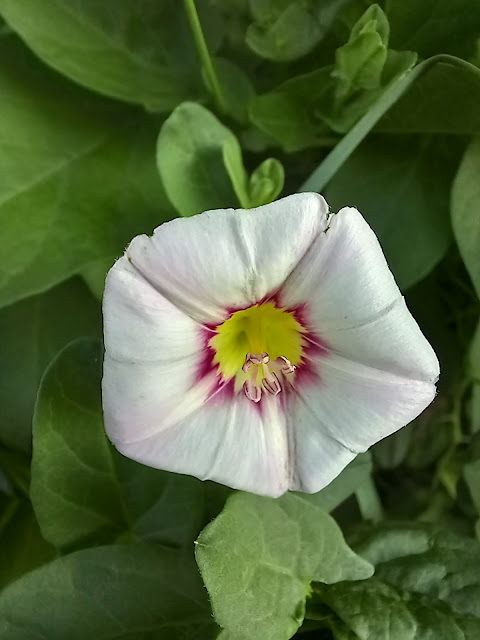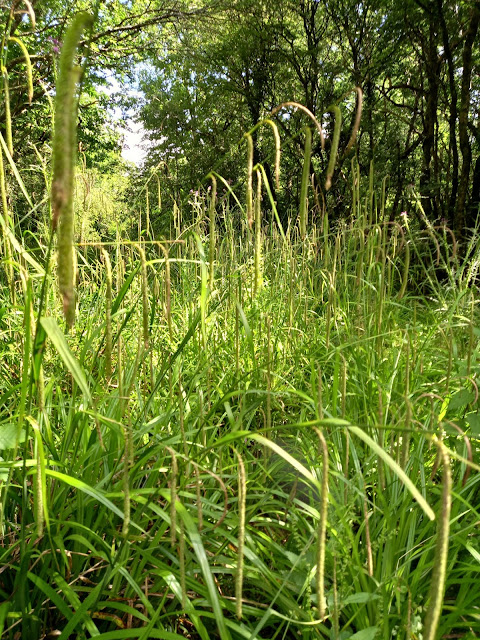On top of Chimney Rock, which is a great monolith breaking off from the mountains like the spout of a teapot, about twenty persons can stand and look down at ten counties and a dozen rivers and valleys. This morning Atlanta looked down alone upon miles of green wheat and light blue rye and upon cotton fields and red clay and terribly swift streams capped with white foam. By noon she had looked at plenty of scenery while the airplane zoomed round and round the rock, and she was hungry when she descended the winding steps to the restaurant, and found Carley Delannux and a girl on the terrace.
"You looked nice up there," he said. "Sort of remote and unimportant -- but nice."
She sighed; she was weary.
"Roger made me climb those steps three times running," she said. "I think it was punishment for sitting up last night."
(from "I'd Die for You", by F. Scott Fitzgerald, written in 1935)
*
Worldwide production of rye (Secale cereale) has tended to go down in recent years. Perhaps younger generations in the traditional rye-eating areas of central Europe are increasingly switching over from old-fashioned pumpernickel and crispbread to pizza and croissants and all the other irresistible things that can be made with wheat. Worldwide production of rye is still dominated by the rye belt that runs from Germany and Poland through to Ukraine and Russia. (Rye outperforms wheat on both heavy clays and light sandy soils prone to drought.)
Another factor is that, unlike wheat and barley, rye does not self-pollinate. Pure breeding stock is difficult to maintain, so the agri-industry has not put very much effort into "improving" rye. That said, there are now cultivars that are resistant to ergot, the traditional scourge of rye.
Rye is now a fairly rare cereal crop in the British Isles. The largest farm is on the Breckland in Suffolk. Some is grown on the Cotswolds. I suppose it was more commonplace in the past (with Robert Burns' "Coming Through the Rye" a doubtful witness).
But other nations have a more significant rye production -- and yes, that includes the USA, as in this N. Carolina panorama, which the movie actress Atlanta Downs gets a bit weary of looking at after a whole morning.
There's a widely-held theory that both rye and oats started out as weeds, contaminants of wheat fields. At that distant time they were both worthless grasses, from the point of view of human consumption.
Naturally the early farmers sought to separate the wheat grain from the grain of these unwanted weeds before sowing next year's crop. But cleansing was not 100% effective. Some rye/oat grain slipped through, and it tended to be the grain that most resembled wheat grain. In other words, the biggest, fattest grain. Thus an inadvertent situation was created in which the wild ancestors of rye and oats were preferentially selected on the basis of bigger, more nutritious grain (this mechanism is known as "Vavilovian mimicry"). The eventual upshot was that they morphed into useful cereal crops in their own right.
*
I love the serendipity that arises from chance encounters with physical books. This was a case in point. I think Kyli got me I'd Die for You, and Other Lost Stories as a birthday present, a couple of years ago. As it happens, though F. Scott Fitzgerald has always been around me I've never read any of his books, until this one. Obviously this was the "wrong" place to start: the barrel-scrapings of his later years, the stories that never got placed, the tryouts that didn´t get taken up.
However, it worked for me. I'm now all eagerness to pick up e.g. The Great Gatsby. But before, I might have been perversely resistant to such a celebrated book.
I'd Die for You, and Other Lost Stories was published in 2017, a volume beautifully pieced together and edited by Anne Margaret Daniel.
Anyway, searching through the debris of these eighteen stories or semi-stories, with all their faults apparent, the author's desperate need for money, the signs of hopelessness and loss of confidence, the patent struggle to maintain the expectation of youthful zest, the sunny clichés, the conventions, the story going off-track and blindly crashing into those same conventions... I enjoyed most of it very much.
But if I make any generalizations about Fizgerald here, forgive me -- I've no right. (I'm like one of those close relatives who know a great writer's work only from ephemera that are completely unrepresentative.)
Fitzgerald in the mid-late 1930s was unhappily working for Hollywood, the main source of his earnings. Some of these pieces are outlines for screenplays; some have Hollywood characters. There's no noir, though there is darkness -- for instance in "I'd Die For You", the stand-out story, in which two women are drawn in to "Suicide" Carley's dangerous atmosphere, while mistaking its nature.
There's little sense of the imminent world war that haunts European writing of the same period. Several of the stories are crazy comedies, for instance "The Couple" and "The Women In the House", or crazy action adventure ("Love Is A Pain"). Some are based round the medical institutions that Fitzgerald was seeing so much of, both on Zelda's account and on his own.
He never got away from writing about the young, beautiful and wealthy. "Travel Together", for instance, starts off bracingly as hobos on a goods train halted outside Dallas. But it turns out that both the principals are really slumming it. The genuine hobos, on the other hand, are portrayed as stereotypical brutish threats to beauty, ejected from the story by the hero. (A view of the lower classes that's pretty much unchanged from the Morte d'Arthur or Arcadia, centuries before.)
There are bit-parts for black Americans, kindly but dismissive, in the comic mode of Gone With The Wind (a screenplay that Fitzgerald contributed to).
Unexpectedly, there's a civil war story here, or rather two. "Thumbs Up" and "Dentist Appointment" both begin with the same arresting scene, in which a Mosby trooper is hung up by his thumbs, though neither of the peace-time continuations is quite able to match this opening.
I was recurrently put in mind of P. G. Wodehouse, another author whose vision was really formed in the twenties: the stories nearly always manage to contrive a sunny ending, a well-matched pair melting into each other's arms. Depth of character, in the Tolstoy or George Eliot sense, just isn't important here.
What is, is a bit harder to say. A pictorial quality, a sharp accuracy of talk, responsive to the crowded scenarios. A feeling of life, of fertility, that's distinctive in the midst of all the popular clichés. I'll finish with a few examples.
The rude town was like a great fish just hauled out of the Mississippi and still leaping and squirming on the bank. Around the wharves spread a card-house city of twelve thousand people, complete with churches, stores, stables and saloons. Walking the littered streets, the newcomers stepped aside for stages and prairie wagons, bull teams and foraging chickens -- but there were also some tall hats and some tall talk, for the railroad was coming through.
(St Paul, Minnesota; from "Dentist Appointment" (written in 1937)).
That winter there were many men for Kiki, but her heart was empty and she paid them off in deflated currency. As if asleep she walked through a February inspection of the colleges, but at New Haven she opened her eyes long enough to search for Rip Van Kamp through the swirling crowd, and not finding him sent him a message to his room. Next day they strolled through a light blinding snow, and his face, statuesque against the winter sky, brought a sudden renewal of delight.
"Where were you last night?" she demanded.
"I haven't got a white tie and tails."
"How ridiculous!" she exclaimed impatiently. "But I've got my plans for you -- gross material ones. I think I've found you an angel. Wait till you hear."
Sitting in his study before a wood fire she told him.
"It's a man named Gittings, class of 1903, a friend of the family . ..."
(Kiki and her protege football player, in "Offside Play" (written in 1937)).
"That's the end of Roger and me," she thought next morning. "I never loved him -- he was only my best friend."
But it made her sad when he did not tell her when to go bed the next night, and it was not much fun now on location or at meals.
Two days of rain arrived and she drove with Carley Delannux back into the hills and stopped at lost shacks trading cigarettes for mountain talk and drinking iron water that tasted of fifty years ago. Everything was all right when she was with Carley. Life was gay or melancholy by turns but it was at all times what he made it. Roger rode along with life -- Carley dominated it with his sophistication and humor.
This was the season of flowers and she and Carley spent a rainy day fixing up a float to represent Lake Lure for the Rhododendron Festival in Asheville that night. They decided on a sailboat with a sea of blue hydrangeas and an illuminated moon. Seamstresses worked all afternoon on old-fashioned swimming costumes; and Atlanta turned herself into a stout bathing beauty of 1890, and they telephoned the little nurse, Isabelle Panzer, to be a mermaid. Roger would drive the truck and Atlanta insisted on sitting in front beside him. She was inspired to this gesture by the vague idea, peculiar to women in love, that her presence would cheer and console the other man.
The rain had stopped and it was a fair night. In Asheville their float took its place in the assembling parade -- there had already been one parade in the afternoon and the streets were littered with purple pink rhododendrons and cloudy white azaleas . Tonight was to be Carnival, wild and impudent -- but it was soon apparent that to plant an old world saturnalia in the almost virgin soil of the resort was going to be difficult; the gaiety was among the participants rather than in the silent throngs from the mountains, who gathered on the sidewalks to watch the floats move by in the shaky and haphazard manner peculiar to floats, with great silent gaps, and crowdings and dead halts.
(from "I'd Die For You" (written in 1935)).
Labels: F. Scott Fitzgerald, Food and drink, Poaceae
























































